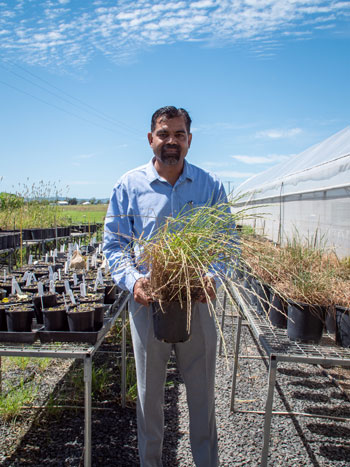Key points
- Annual ryegrass is germinating in summer in northern grain growing regions
- This is outside its original winter germination window
- Research is needed to find out why and what can be done
Annual ryegrass is expanding its seasonality and Professor Bhagirath Chauhan from the Queensland Alliance for Agriculture and Food Innovation (QAAFI) says more research is needed to find out why.
The weed expert has recently confirmed that annual ryegrass is germinating in summer in the northern region. This is well outside its original winter germination window; seeds are now being produced in temperatures as high as 40°C.
“We need to work out why it is growing outside of its normal window and why it has been happening in Queensland and northern NSW in the past few years,” Professor Chauhan says.
“We know about its biology and how it works in other parts of the country, but we need the same information here. Are they different biotypes? We also need to learn from the experience of southern and western grain regions to ensure we don’t get to the point where it’s difficult to manage.”
 Professor Bhagirath Chauhan says annual ryegrass is now germinating in summer in northern grain growing regions. Photo: Megan Pope
Professor Bhagirath Chauhan says annual ryegrass is now germinating in summer in northern grain growing regions. Photo: Megan Pope
Annual ryegrass can spread quickly, often carried accidentally by vehicles or, in one case, by a hay bale that fell from a truck. It can also travel in floodwaters, but seed viability will be variable. Annual ryegrass can quickly spread from the roadside into a paddock and grow alongside a crop, he says. “Even if just one per cent of these plants produce seeds, that is still enough to expand its population. One ryegrass plant can produce more than 40,000 seeds, which can grow into 40 or 50 plants per square metre.”
The adaptation of annual ryegrass, which is a winter weed in the southern and western regions, is a potential disaster that could cost many millions of dollars across all cropping systems, he says. Not only do the weeds compete for nutrients, water, sunlight and space – as well as harbouring insect pests – they are resistant to most herbicides.
“We rely on glyphosate in the north to control weeds in fallow areas and ryegrass has developed resistance even to that, which means it will produce seeds that go into the soil’s seed bank and germinate over many seasons,” Professor Chauhan says.
Professor Chauhan started a GRDC-supported project in 2017 to find instances of summer emergence. More recently, COVID‑19 lockdowns and floods have reduced his capacity to travel and find incursions, but industry contacts are still sending in samples.
“My initial concern was that we found it near a cotton field and, with glyphosate resistance, we knew it could spread. Now we need to continue the work, looking into biotypes and exploring why it is changing its germination times.”
More information: Bhagirath Chauhan, b.chauhan@uq.edu.au; Dr Michael Thompson, Michael.Thompson@grdc.com.au

























































